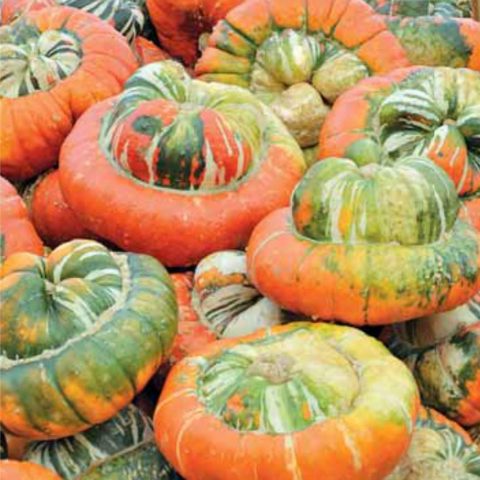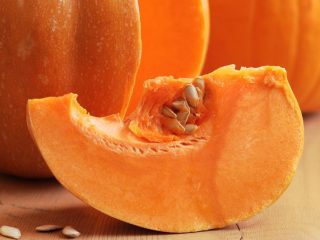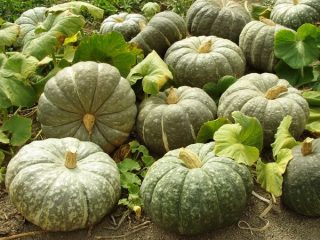Content
Turban pumpkin is a vine-like plant that grows wild in the tropics. Belongs to the Pumpkin family. It is generally accepted that the decoration of a garden is flowers or flowering bushes. Unusual vegetables, in particular decorative pumpkins, cope with this task no worse.
Description of the variety
The Turkish turban is characterized by rapid growth. In a few weeks, the stem can grow up to 6 m. This feature allows the pumpkin to be used for decorative landscaping. The lashes cling to the support with their antennae and quickly rise up. A climbing plant can be used to camouflage a fence, mesh, or decorate an arch.
The foliage is large, round in shape, five-lobed. The surface is wrinkled, with spiny hairs. The leaves are held on long, hollow stems. Flowers are single, large, yellow. The inflorescences of the Turkish Turban pumpkin are predominantly unisexual. The flowering process begins in the second half of summer.
Description of fruits
The most interesting thing about the Turkish Turban pumpkin is its fruit. The shape resembles two small pumpkins fused together.The upper part of the turban-shaped fruits has a bright orange tint, and the lower part is painted white.
The length of the vegetable is 25-40 cm, diameter 15 cm. The surface can be smooth or bumpy. There are practically no two identical fruits on the same plant. They always differ in color and pattern.
Characteristics of the variety
The Turkish Turban pumpkin easily tolerates periods of lack of rain. However, the big disadvantage of the plant is the complete lack of frost resistance. Young bushes cannot tolerate temperatures dropping even to -1 °C. Apart from frost, ornamental vegetables do not respond well to poor soil. To obtain a bountiful harvest, it is better to water with solutions of mineral fertilizers.
Resistance to diseases and pests
The Turkish Turban pumpkin suffers from fungal diseases. The bushes become covered with black mold, as a result, growth and development stops.
- The most common disease in the Turkish Turban variety is powdery mildew. Symptoms: white coating on leaves and fruits. The affected areas dry out and fall off over time. You can get rid of the disease using fungicides or timely removal of the affected plant.
- Bacteriosis is characterized by brown spots on the leaves. When the process is prolonged, ulcers occur. For prevention, the Turkish Turban pumpkin is sprayed with Bordeaux mixture. If signs of illness appear, treat with a mixture of copper sulfate and lime.
- Root rot affects the root system and stem of a vegetable crop. This occurs due to sudden temperature changes. Sick plants are treated with a solution of copper sulfate and zinc sulfate.
- White rot. The causative agent is a marsupial fungus.The development of infection occurs in conditions of excess moisture. Rotten areas are cut off and sprinkled with activated carbon. Prevention of fungal disease - moisturizing with warm water.
- The Turkish Turban pumpkin suffers from melon aphids, the size of which is 2 mm. Leaves and flowers wither and fall. The drug Karbofos or wormwood infusion allows you to get rid of the insect.
- Slugs cause a lot of problems for the Turkish Turban pumpkin. During the rainy season, their activity increases. They feed on the leaves of the bush. Pests must be dealt with quickly, otherwise they can live in one place for several years. To do this, distribute a mixture of slaked lime and ash in a 1:1 ratio around the plant.
Is it possible to eat Turkish turban pumpkin?
This question interests many gardeners who plan to plant a decorative pumpkin on their plot. Without a doubt, unusual fruits are often used to decorate the yard. However, Turkish Turban pumpkin can be eaten. The young vegetable has thin, delicate skin. They prepare stews, casseroles, and salads from it. Fully ripened fruits are covered with a dense, hard crust. The pulp acquires a bitter taste. Therefore, this vegetable is used to feed livestock.
Use of decorative pumpkin
In the garden, the Turkish Turban pumpkin looks beautiful and original. The fruits stand out brightly against the background of the green foliage of the vines, but they can be used for crafts. The vegetable is used for burning paintings and decorative painting.
To create an interior element of the composition, the pumpkin must be in a dried state. Therefore, preliminary preparation of the vegetable consists of performing the following steps:
- sort through the entire harvest, selecting ripe pumpkins;
- the stalk must be completely dry;
- the fruit is washed with soapy water and wiped dry;
- transferred to a room with good ventilation for further drying;
- constantly inspect vegetables, promptly removing rotten ones;
- if mold is noticed on the peel, treat it with antiseptic agents.
The Turkish Turban pumpkin is completely dry when it is thrown into a container of water, but it does not sink. Next, you will need to polish the surface of the vegetable using sandpaper. This way, you will be able to get rid of unevenness and husks.
After completing all the preparatory work, they begin to cut out drawings on the walls and paint them. To increase strength, rub the surface of the Turkish Turban pumpkin with wax.
Pumpkin dishes are made using a drill. Drill holes of appropriate diameters. But first, the core is opened and the seeds and pulp are removed.
Growing technology
The size and quantity of the harvest directly depend on the growing conditions of the Turkish Turban pumpkin. It has been noted that the plant grows well in light, fertile soils. Preferably loam or sandy loam, calcareous soils, and the vegetable does not tolerate acidic soils.
A secluded place protected from cold winds is suitable for planting. Turban pumpkin is a sun-loving plant, but light shade is allowed. Without sun, vegetables grow and develop poorly. The color is dull. The more light, the more beautiful the fruits. Of course, you can plant pumpkins on the north side of the house, but then you should not expect an abundance of inflorescences and bright fruits.
Turban pumpkin is an annual plant that does not tolerate cold temperatures. Therefore, it is advisable to plant in the ground using seedlings.
- Vegetable seeds are soaked in a growth stimulant solution.
- Wrap in gauze and place in a dark place for 2 days.
- Prepare single containers with a volume of at least 0.5 liters and a sunny windowsill.
- The substrate should include turf soil and sand to give it a loose consistency.
- Sprouted seedlings are hardened off daily. First take it outside for 20 minutes. Then the length of stay is gradually increased.
- The Turkish Turban pumpkin is planted in open ground in late May or early June, when night frosts have passed.
- The distance between the holes is approximately 40-60 cm. The embedding depth is 15-20 cm.
- When planting a plant from a cup, you should be careful, as you can damage the roots.
- The seedlings bloom in June, and the first fruits begin to form in mid-July.
Decorative pumpkin needs rare but abundant watering. The soil is loosened regularly. To make the bush lush, pinch the top. And when the size of the stem reaches 150 cm, lateral shoots will appear.
When growing green mass, nitrogen-containing fertilizers are fed. For the formation of fruits and flowers - potassium and phosphorus preparations. The Turkish Turban pumpkin prefers organic fertilizers: chicken droppings, mullein, rotted manure, humus.
The vegetable is harvested in dry weather, around September-October, before frost sets in. In the southern regions - after the foliage has dried. During the harvesting process, it is necessary to preserve the stalk and prevent damage to the Turkish Turban pumpkin.
Conclusion
Turkish turban pumpkin is an ornamental plant. Suitable for use for culinary purposes or creating landscape compositions. Ripe fruits make beautiful handmade crafts: vases, boxes, candle stands. Moreover, the basis for such unique things can be obtained without much effort. The vegetable crop is undemanding, grows quickly and delights with numerous fruits.
Reviews












